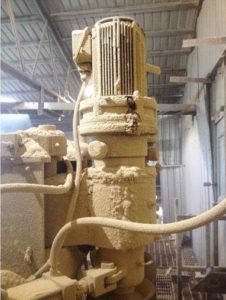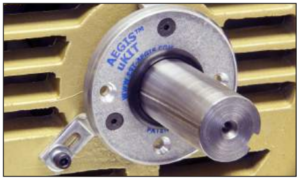Q1. How important is a clean environment for the ring’s operation and lifetime?

This is a good candidate for internal shaft grounding.
A1. It’s important, but not super-critical. AEGIS® Rings’ conductive microfibers are pretty tolerant of contamination. They cut through small amounts of dust and grease. You want to install the ring in whatever location is best – it can be outside at the drive end, inside the motor, or at the non-drive end, maybe inside the end bell. You can also put an O ring on the shaft and slide it up to SGR. That prevents a lot of contamination. People also add slingers or covers to prevent contaminant ingress. For larger motors, we make the PROSL-R with a rubber gasket.
But we’ve got grounding rings in all kinds of applications – paper mills, mines, cement milling. Dusty, mucky places. We know of one limestone processor around the Great Lakes with lime dust everywhere, and grounding rings everywhere. And those rings are still working.
The bottom line is you want to keep the rings as clean as you can, but don’t sweat it too much if they get a little dirty. If there’s ever a question of whether they’re still working, test the shaft voltage. We’re here for you if you ever need help with that.
 Q2. How is the ring grounded/bonded to the motor frame?
Q2. How is the ring grounded/bonded to the motor frame?
An AEGIS uKIT with rubber o-ring to protect the conductive microfibers from contamination.
A2. Just a preliminary bit of jargon: This is really bonding we’re talking about. Grounding has a few meanings, with often subtle differences. But electrical bonding always means that two objects are in electrical contact. That is, charge can flow easily from one to the other. In the case of a grounding ring, charge flows from the motor shaft to the ring. The question is, how does that charge get off the ring and onto the motor frame?
Through the mounting hardware (or conductive epoxy). Our basic “clamp-on” shaft grounding rings are held on by clamps bolted to the motor frame. Here, the bonding is through the clamps and screws. Bolt-through rings have screws through them into the motor frame. Fairly obviously, the bonding is through the bolts. With AEGIS uKITs, the bonding is the same but with the addition of mounting brackets.
Many motor repair contractors install press-fit rings. Here, they bore a cavity into the motor frame or bearing retainer ring, and press the grounding ring in. So the bond here is direct metal-metal contact between the ring and the frame. With conductive epoxy mounting, you grind away the paint from the motor frame where the ring will be mounted, so the bond is from the ring, through the epoxy, to the frame.
We should point out that while the mounting bonds the ring to the motor frame, the frame also needs to be bonded back to the VFD. This bond can be through the facility ground. But it’s best to use a good VFD cable, including symmetric ground wires and shielding (braided or foil). Good cabling makes a big difference to motor grounding. It also helps with electrical noise (EMI/RFI) in your facility.
Q3. Can we get away with a higher shaft voltage amplitude with a good choice of bearing grease?
A3. Not really. Whatever grease you use – and you should always follow the bearing manufacturer’s recommendation – you will always end up with a thin film between the bearing rollers and races. Voltage will build up across that film, and arcing will occur without protection. And no matter how good an insulator the grease starts off as, its insulating strength will always go down. That’s because as arcing occurs, you’ll end up with tiny bits of metal blasted off the bearing metal going into the grease. That’s why grease blackens over time. All those metal bits make the grease more conductive, so you have even more arcing occurring.
About twenty years ago, a lot of people’s thinking was that conductive grease was the way to go. The thought was: Let the shaft voltage discharge easily, and less-destructively. But there were all kinds of problems with this. Among other things, it turns out that the conductive particles in this grease were abrasive. You want bearings to stay smooth; you don’t want abrasive powders in your grease. So people would use this grease, and it would work at first, and then a year or two later, the bearings would overheat and fail due to this abrasion.
AEGIS Rings also come with a 2-year extended warranty against bearing fluting damage. No other form of protection against VFD-caused bearing damage offers a warranty like this.

To learn more about AEGIS shaft grounding and best practices for electrical bearing protection, sign up for a training. We offer monthly live training webinars, and - pandemic restrictions permitting - we can also visit your facility to review your exact application.


